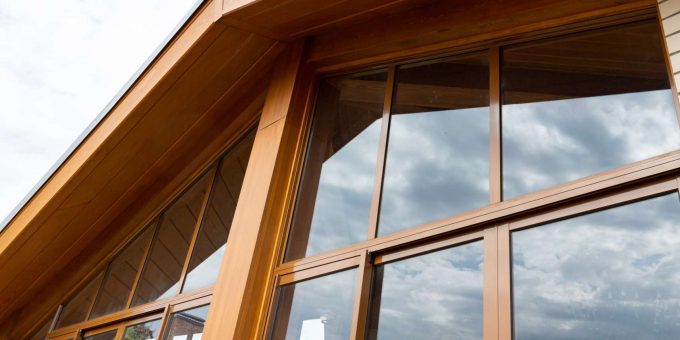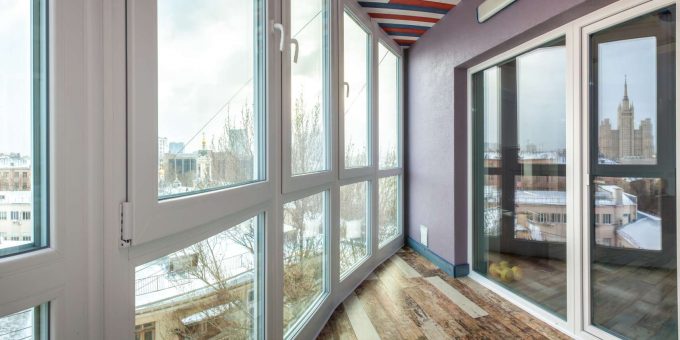- How glass becomes energy efficient?
- Low emissivity film
- Principle of operation
- Degree of vulnerability
- Versatility
- What is the difference between ordinary glass and energy-saving glass?
- By cost
- For heating costs
- Technology Benefits
- Less weight
- Efficiency all year round
- Reflects UV rays
- No condensation
- Reduced heating costs
- Efficiency against the background of standard windows
- Energy efficiency class
- How to choose the right solution?
- Installation tips from experts
- Profile width
- Installation strictly according to GOST
- Myths and reality - glass, that repels heat
The first energy-saving windows appeared in the 1960s.. But then the idea did not gain mass distribution.. It's been half a century, and the ability to keep warm in the house, lower heating bills attracts more homeowners. Therefore, in our article we decided to understand the actual issue, how energy-saving windows differ from ordinary ones in reality, and how profitable it is to install them.
How glass becomes energy efficient?
Through the window of the house leaves about 35% heat, and 2/3 of this amount falls on the glass. Hence the natural desire to reduce its thermal conductivity.
energy saving glass - these are ordinary float glasses *, on the surface of which a low-emissivity film of metal oxides is applied. It often contains silver oxide.. The principle of operation can be compared with a thermos. Passes solar shortwave energy from the street into the room, but retains long-wave heat from working heating devices inside.
*Float glass stands out for its high optical performance. Molten glass mass is poured onto a layer of molten metal, like tin. Hence - uniform thickness over the entire size of the glass plate, high surface quality.
To better understand, due to which there is an increase in insulating characteristics, deal with the device, development properties more.
Low emissivity film
Based on float glass, on which a non-ferrous metal coating is applied by spraying (india, lead) and oxides. Good, if the composition includes a layer of silver or chromium. It provides enhanced reflective performance. It is impossible to notice such a coating with the eye.. Only if you look at the glass at an angle, as in the case of a car windshield. Its thickness is about 0,12 m.
Principle of operation
The material has limited transparency in the infrared part of the spectrum, which corresponds to thermal radiation. Glass successfully reflects IR rays, due to which heat losses in winter are reduced, and in summer the amount of heat entering the interior is minimal. With the onset of the cold season, it retains up to 90% heat inside a house or apartment.
Degree of vulnerability
Modern technologies make it possible to make spraying invulnerable to environmental factors, mechanical action. No need to be afraid, that inaccurate window cleaning or something else will damage the coating. The developers have thought of everythingit isloches.
Versatility
Technology has made it possible to combine the advantages of different glasses - energy-saving, tinted, tempered, self-cleaning. Such products absorb radiation like photo filters. Keeps the room cool in summer, however, this does not affect the quality of lighting. In winter, it will be warm near the glazed surface, comfortable.
The material can be made convex or give it a non-standard shape. Technology opens up great opportunities for experimentation, original solutions.
What is the difference between ordinary glass and energy-saving glass?
If you put the glasses side by side and compare visually, no difference. Only when viewed at an angle, the energy-saving will cast in purple. However, there is a big difference in heat, which glass passes there, where is colder. Ordinary material passes up to 84% heat, while the same indicator for the energy-saving model is only 10%.
Many customers are worried about the cost. However, let's compare the products in more detail..
By cost
Coated double glazing is always more expensive. However, it will cost its user less to operate.. Besides, if we compare the thermal conductivity of different solutions, get an interesting result.
Single-chamber energy-saving window exhibits a higher resistance coefficient, than a two-chamber package without spraying.
The cost of additional glass offsets the application of a low-emissivity layer. The result is, that prices are proportional. But the heat-intensive design weighs less. Hinge load, pens, pins are smaller, so, accessories will last longer. The risk of unplanned repairs is minimized.
For heating costs
If you are a happy owner of gas heating, the difference between the standard and energy-saving financial window is small. This situation continues until, until there is growth prices on gas.
For those homeowners, who uses electricity or diesel fuel for heating, the difference will be 25-27 thousand rubles for the heating season.
Technology Benefits
If the coefficient of resistance to heat transfer of a conventional single-chamber package is 0,32, then in the case of the energy saving package, it rises to 0,59. For a two-chamber package without spraying - 0,47, sprayed - 0,64. The difference in technical characteristics is palpable, and with it, savings on utility bills are visible.
Among the advantages, one should also highlight:
Less weight
If you need to reduce the load on the floor or foundation of the building, it is possible to use non-two-chamber double-glazed windows with standard glasses, and a single-chamber heat-saving model. She will weigh less. so, you will achieve your goal, and also reduce daily pressure on fittings.
Efficiency all year round
The low-emissivity coating works on the principle: heat returns to, where is more. Reflected outside in summer, so the room is not heated, and the air conditioner has to be used less often. In winter, it moves towards a heated room, so the homeowner will pay less for heating.
Reflects UV rays
Works great for UV protection, which are harmful to humans, home interiors. Thus, you additionally save furniture, blinds, wallpaper, parquet from burnout, which inevitably occurs under the direct rays of the sun.
No condensation
Ordinary double-glazed window is not heated by anything. Its surface is quite cold, therefore, when it comes into contact with heated air, condensation forms on it. Low-emissivity materials are heated by sputtering, so the condensation problem, freezing of windows or window sills exclude.
Reduced heating costs
This applies not only to ordinary apartments or houses., but also large rooms. Heated air cannot leave the room, since the low-e glass reflects it in that direction, where the temperature is higher. Thus losses are reduced, and the heating intensity along with them.
Efficiency against the background of standard windows
To make it clearer, how plastic windows work, compare the technical features of designs with low-emission and conventional glasses.
| Number of cameras | one | one | two | two |
| type of glass | Standard | Energo | Standard | Energo |
| energy transmission (%) | 78 | 51 | 72 | 50 |
| Heat transfer resistance (Ro, m²K/W) | 0,32 | 0,59 | 0,51 | 0,78 |
| Degree of light reflection (%) | 2 | 10 | 3 | 11 |
| Missing the world (%) | 81 | 73 | 72 | 66 |
| Noise absorption (Db) | 24 | 24 | 37 | 37 |
| Ratio prices and quality | Low | Good | Good | Average |
An energy-saving window is more expensive than a standard one. However, according to the characteristics, it is necessary to compare a single-chamber heat-saving with a two-chamber conventional. In this case, the result is approximately the same. However, the floor load, foundation, accessories will be less. It is advantageous to install products with low-emissivity glasses in narrow walls, as well as heated balconies or loggias.
Energy efficiency class
This marking helps to evaluate, How much can you save on heating, air conditioning in different seasons of the year. Russia has a combined scale (for the whole year):
- E - low class;
- D - reduced;
- C - standard;
- B - high;
- A - elevated.
The number of climatic regions in Russia is huge. Each of them has its own requirements for glazing.. for example, in the Moscow region it is customary to use products of high, high class. Although the heat, colds are in the middle climate range.
How to choose the right solution?
If you are going to install double-glazed windows with low-e glass, pay attention to the following points:
- the distance between the glasses does not exceed 25 mm, and better, if it is 10–15 mm, otherwise, thermal insulation characteristics are reduced;
- the label must contain the name of the technology;
- you can check yourself, Is there a spray or not?;
- the seller must, upon request, provide a certificate for the products, which confirms its low-emission properties.
If the product has already been purchased, and the certificate was not presented to the buyer, you can check the presence of sputtering yourself. To do this, just bring a lit match or lighter to the surface of the double-glazed window. In an ordinary product, the flame will be reflected without shades, reddish highlights will be present in low-emission. You can also look at the material at an angle. If you see a lilac shade, like on the windshield of a car, spraying is present.
Construction equipment will give a more accurate answer., that allow you to determine the thickness of the material, the presence of metal particles.
Installation tips from experts
For technology to work, you need to follow a few simple rules.
Profile width
For warm double-glazed windows, it is recommended to choose wide profile systems. We do not recommend taking frames wide 6 cm. The narrow design, even when installing an energy-saving double-glazed window, will lead to freezing, condensate settling. It is advisable to choose profile systems with a width of 70 mm with 5–6 chambers.
Installation strictly according to GOST
Do not trust the installation to specialists, which do not work according to GOST. Otherwise, all financial investments will be useless. Errors in the creation of a mounting seam or poor-quality mounting materials will lead to, that the system is simply depressurized. It doesn't matter here, what glasses do you use, when insulation breaks. Be sure to use vapor barrier, waterproofing films, which protect the assembly seam from environmental factors, destruction.
Myths and reality - glass, that repels heat
A single-chamber energy-saving window costs the same, how much and analogue with double-glazed windows. However, in terms of technical characteristics, it is ahead of its competitor.. The conclusion: it's better to pay a little more at once, but then get a number of important advantages.
You can lower your heating bills, get rid of the condensation, zapotevaniя, reduce the load on the fittings and base. And it's not a myth. The latter is often critical when glazing balconies., loggias or houses with thin walls. The technology proved its worth in bench tests, durability. the main thing, like in any business, choose a reliable manufacturer, installer. Then you will be able to take advantage of all the advantages of development on your own experience..
"Window Factory" has its own time-tested development of energy-saving double-glazed windows - Thermal Pack™ 4.0 LGC, which can be installed in any of our windows and allows you to keep the heat in the house and save on heating. When buying a window, we offer the installation of a thermal package at the price of a conventional double-glazed window. Learn more about the benefits and guarantees on our site.












